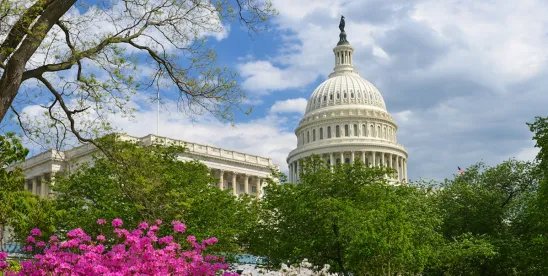| This is the first in a series of articles Jones Walker LLP is providing that will explore the impact of the 2024 Election on Environmental Law. |
|
There are several significant environmental regulations currently pending or recently implemented under the Biden-Harris administration that may be altered with a change of administration. These regulations demonstrate the stark contrast in approaches to environmental regulation with those from the Trump administration. If history can be used as a guide, pending and current regulations as well as the stances of regulatory agencies in defending regulatory actions may change after the election. Such regulations include the Council on Environmental Quality (CEQ) revisions to the National Environmental Policy Act (NEPA), and the United States Environmental Protection Agency (EPA) Clean Air Act (CAA) New Source Performance Standards and Emission Guidelines for oil and gas facilities and fossil fuel power plants. NEPA Implementing Regulations NEPA, signed into law in 1970, requires federal agencies to conduct environmental reviews of major federal actions, and established the CEQ to develop guidelines through regulations for the implementation of NEPA. NEPA’s regulations had remained relatively unchanged since 1978 until the streamlining effort by the CEQ under the Trump administration in 2020 (the “2020 Rule”), which limited the scope of judicial review and eliminated the consideration of cumulative effects, among other significant changes.[1] To address the 2020 Rule, Congress and the CEQ, under the Biden administration, implemented a phased reversion and restoration in 2022, 2023, and 2024, which would likely remain the status quo under a Harris administration.[2] One such change by the Biden administration is that on May 1, 2024, CEQ finalized its Bipartisan Permitting Reform Implementation Rule (the “2024 Rule”) to revise its regulations for implementing NEPA, which also included previous amendments to NEPA under the Fiscal Responsibility Act of 2023 enacted by Congress and signed into law by President Biden on June 3, 2023. A Trump electoral victory would likely result in the CEQ proposing regulations that will restore the streamlined measures promulgated by the Trump administration in the 2020 Rule. However, each iteration of rulemaking in recent years has been met with challenges by states and environmental groups, which are currently pending.[3] Therefore, the Trump administration, if successful in November, will need to navigate the impacts of a regulation change. EPA’s Methane Rule for Oil and Gas Operations[4] Methane and volatile organic compound (VOC) emissions from the Crude Oil and Natural Gas source category are regulated under CAA Section 111 New Source Performance Standards (NSPS) and Emission Guidelines. Under this section, on March 8, 2024, EPA promulgated new standards (2024 NSPS) to reduce emissions of methane and VOCs from oil and gas production and processing operations and from natural gas transmission and storage operations. The new regulations apply to new, modified, and reconstructed sources as well as procedures applicable to existing sources. The rule includes the phaseout of routine flaring of natural gas and requirements for routine monitoring, and provides for a strong oversight role by EPA. Under a Harris administration, these rules would likely remain unchanged. The Obama administration was the first to implement direct regulations on methane emissions in 2012[5] and 2016,[6] which were rescinded in two rulemakings in 2020 under the Trump administration.[7] And in due course, Congress and the Biden administration revoked some of the 2020 rulemakings by the Trump administration and issued their own rules addressing methane emissions, including the 2024 NSPS. Trump’s election success would likely result in another proposal to reestablish the standards in the 2020 rulemakings. However, as with the NEPA rulemakings, there are pending challenges to each administration’s methane rules, which could come into play in deciding on how to address each one. CAA Standards for Fossil Fuel Power Plants[8] On May 9, 2024, EPA published its final rule establishing emission guidelines and NSPS to reduce greenhouse gas (GHG) emissions from fossil fuel-fired electric generating units (EGUs).[9] The NSPS and emission guidelines are based on “the best system of emission reduction” (BSER). The rule establishes various compliance deadlines, including setting a 90% capture as BSER for existing coal-fired steam generating units, with a deadline of January 1, 2032. Regulations on GHG emissions have been a subject of debate over the past three presidential administrations. The Clean Power Plan, which was promulgated in 2012 and 2016 by the Obama administration, was repealed and replaced with the Affordable Clean Energy Rule by the Trump administration. Years of litigation ensued before the May 9, 2024, rule finalized the repeal of the Affordable Clean Energy Rule. An electoral win by Donald Trump could result in the revocation of the Affordable Clean Energy Rule with considerations to the challenges pending in federal district courts over this rulemaking. As demonstrated, the upcoming election could yield changes for industries affected by these regulations. Several significant environmental frameworks could alter business operations and regulatory actions, highlighting the importance of being familiar with these changes. |
|
[1] 85 Fed. Reg. 43304 (July 16, 2020). [2] 87 Fed. Reg 23453 (April 20, 2022), the “Phase 1 Rule”, 89 Fed. Reg. 35442 (May 1, 2024), the “Phase 2 Rule”, and Pub. L. No. 118-5, 137 Stat. 10 (June 3, 2023)(“Fiscal Responsibility Act of 2023”). [3] See challenges to the 2020 Rule in Alaska Cmty. Action on Toxics v. Council on Env’t Quality, No. 20-5199 (N.D. Cal. 2020) and California v. Council on Env’t Quality, No. 20-6057 (N.D. Cal. 2020). See challenges to the 2024 Rule in State of Iowa v. Council on Env’t Quality, No. 24-89 (D.N.D. 2024). [4] 89 Fed. Reg. 16820 (Mar. 8, 2024). [5] 77 Fed. Reg. 49490 (Aug. 16, 2012). [6] 81 Fed. Reg. 35824 (June 3, 2016). [7] 85 Fed. Reg. 57018 (Sept. 14, 2020) and 85 Fed. Reg. 57398 (Sept. 15, 2020). [8] 89 Fed. Reg. 39798 (May 9, 2024). [9] 89 Fed. Reg. 39798 (May 9, 2024). |





 />i
/>i

